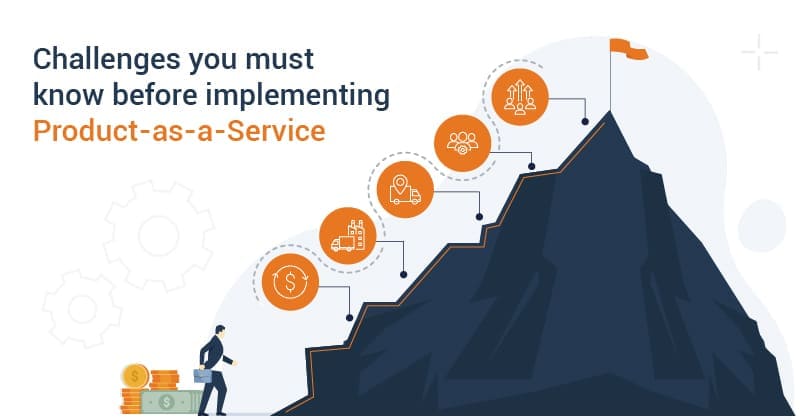Equipment-as-a-Service is a business model that has an estimated potential of 2 trillion dollars, according to McKinsey. Nearly one in three manufacturers are trying to deploy an Equipment-as-a-Service model, which means that if not embraced early, you would eventually lose your customers. While it’s exciting to incorporate the latest and innovative concepts into your business, it is an uphill battle.
With nearly two decades of experience in the equipment rental and industrial manufacturing industries, we at To-Increase have helped multiple enterprises across the globe streamline their business with industry-specific software embedded in Microsoft Dynamics 365.
In our experience, we have seen the manufacturing industry move to a more circular economy and the challenges a company faces while shifting from a purely product-based to a service-oriented product-based approach.
This article will discuss the common challenges while implementing Equipment-as-a-Service, so you are better prepared for the transition process.
What is Equipment-as-a-Service?
Equipment-as-a-Service (EaaS) is a business model that enables industrial manufacturers to deliver products and rental support services as part of long- or short-term subscription contracts. You can offer your products or equipment to customers for a fixed period on rent or lease and gain periodic payment for the equipment used.
It’s also known as Product-as-a-Service, Asset-as-a-Service, servitization, switching from CAPEX to OPEX, and has subcomponents, such as multiple revenue streams, pay-per-use, and consumption-based revenue.
To learn more about Equipment-as-a-Service and its advantages, click here.
What are the common challenges while implementing Equipment-as-a-Service?
The EaaS model involves remodeling your entire business strategy, rethinking your operations, and producing new ways to capture the market. You could face specific inevitable challenges while implementing EaaS in your business. Let’s see some of the challenges, so you know what to expect and can stay ahead of them.
1. Refining your financial structure
Price-setting of the service component is difficult
Price-setting for a product is relatively easy, but it can be challenging to set pricing for the service components of your offering. You must know the total lifetime of how much service to provide, which is hard to calculate accurately. It must be set up without overcharging customers or undervaluing your activities.
Managing multiple revenue streams
EaaS brings diverse types of revenue from multiple channels, and you’ll have to prepare your business to manage these streams. Not having defined processes for handling revenue streams – be it renting, leasing, selling, or pay-per-use could result in unaccounted usage and revenue loss.
Prefinancing assets
With EaaS, the ownership of the product remains with you. You have your assets on your balance sheet, so you’ll have to pre-finance your products to change the payment model from up-front payment to pay-per-use. Remodeling your finances would impact your P&L statements, balance sheets, revenue generation, and asset management.
2. Supply chain integration and logistics
Rethinking your entire product lifecycle
Unlike your previous business model, which ended at ‘selling,’ you must look at providing your products for a defined period and returning them to inventory, changing the lifecycle of your products. You need to set up asset return processes, agreements, and Service Level Agreements (SLAs) for all the suppliers, vendors, and distributors, which could be an extensive process.
This demands a well-integrated supply chain developed after multiple discussions with your supply chain partners.
Organizing reverse logistics
With EaaS, your business will have to accommodate the reverse logistics of your service-based products. You need to create the foundation to take back products and decide to reuse, refurbish, recycle, or declare end-of-life. Organizing this for each of your products is a costly and time-consuming affair.
Extensive adaptations are required at an operational level and to the back-end processes for managing reverse logistics.
Add renting and leasing to existing business
As a company implementing EaaS, you will introduce renting and leasing initiatives on top of your existing business model. You won’t make a complete switch, instead a transition into EaaS. This could introduce risks of over-stretching your teams and the need to maintain existing business and revenue streams. The process could be overwhelming initially and could reduce your focus on developing the new initiative.
Change in product warranties
You now own products, and there is no transfer of ‘ownership.’ You will have to explore how to go about product warranties and take care of maintenance during product usage. This requires effort from multiple teams, including operations and legal, while complying with local regulations.
3. Selling ‘experience’ and not ‘products’
Convincing customers
With a new business model, you have to work on convincing your existing and future customers to consider a new offering, with associated new payment models, contracts, and responsibilities. The inability to have your target customer base accept this new strategy can be detrimental, and you must persuade them to see the value in the new offering.
Focus on customer service
Customer service is at the heart of a successful EaaS strategy, and it’s not easy to ensure you’re delivering it to the highest possible level each time. Unreliable or inconsistent customer experiences could undermine your efforts to include service-based offerings. Hiring the right people and using appropriate systems to help you satisfy your customers can help you increase the overall quality of your services.
Getting fresh perspective and skills
Thinking in terms of services rather than products requires a distinct set of skills. Your business success does not end with how well a product works but also how happy your customers are with the service it offers. While both require design abilities, you have to consider customer goals when providing a service, which is different from designing a product.
Redefining marketing strategies
Adding services to your products includes redefining your go-to-market plans and positioning your offerings to your audience, which requires a change at every level — from how you communicate on media platforms to your website. You must also find your customers' hidden needs and intertwine them in your marketing.
4. Volatile cash flow
Stabilizing revenue
There is a certain unpredictability in revenue because of the flexible nature of contracts with your customers. You could experience a notable change in your monthly income due to seasonal changes, which becomes more demanding if you have a difference in the volume of services provided. Managing a steady cash flow and leveling revenue streams, at least for the first few months, won’t be a piece of cake. You may be in a state of change and financial fluctuations for an extended period and can only grow at a pace your business can handle.
Dynamic industry trends
Customer spending habits are continuously changing, and you should adjust your services to meet the market demand. With EaaS, the customer needs, and your overall service offering must complement each other, which means you must keep track of trends, which is a continuous effort.
Entering a new market
EaaS would be an ‘innovation’ in your business — a model you are trying and testing to increase your business’s revenue. Since you are moving into uncharted territory, you need to assess the risks, thoroughly check feasibility, and prepare for a degree of uncertainty. You can predict your income but only see the results after implementing the model, as there is no historical data to your advantage.
5. Facilitating change management
Transforming mindsets
You are tasked to change your business's approach from purely selling products to also providing services. There needs to be a shift from a product-centric perspective to a service-based, customer-centric mindset. This could mean facing resistance and loads of questions – and you need to put in the work to bring about a successful transformation.
Aligning with leadership
Getting the leadership and management team onboard with the entire idea of EaaS is crucial. Committing to EaaS is an organization-wide change with a cultural, business, and technological impact. Senior management may see any big moves as a risk, and it could be challenging to have them all on the same page.
Hiring the right people
EaaS requires a leader within the company who can authorize the necessary strategic change. It usually does not fit a single portfolio and requires someone with a cross-functional and creative approach. Change needs to happen from the top down, but you must also engage staff at every level, spend time mapping visions, and keep the entire organization cohesive through the transition.
How can you overcome the challenges of Equipment-as-a-Service?
The first thing to do once you've decided to implement EaaS is to assess where you are in the transition journey and begin analyzing and preparing a list of all the gaps you must address. Here are eight steps to consider to becoming EaaS-ready:
1. Assess the investment and return
2. Carry out an in-depth product analysis
3. Plan your revenue models
4. Initiate product redesign with the Internet of Things (IoT)
5. Define logistics and operations
6. Prepare your business for change
7. Ensure you have the right technology to support EaaS
8. Implement the EaaS model
To get an in-depth understanding of the steps mentioned above, read our 8-step guide on how to implement Equipment-as-a-Service.
How can we help you with Equipment-as-a-Service?
With growing business processes and operations, you need the right people, strategy, and technology to address these increasing needs. While you can internally work on getting the right people and planning your strategy, you must carefully decide on the right technology. The software systems you select will provide the backbone of the entire transition and will be responsible for the continued success of the EaaS business model.
We can support businesses shifting to Equipment-as-a-Service with our extensive portfolio of solutions embedded in Microsoft Dynamics 365. Our solutions can take care of your end-to-end needs, from renting, engineering, sales, order fulfillment, maintenance, contract renewals, and upgrades. You can read more about our rental software, DynaRent, by downloading the solution factsheet.
Alternatively, if you are still in the initial stages of your EaaS transition, you could explore more about the offerings of rental ERP software by viewing our ERP essentials checklist. This checklist will provide you with information on:
- Benefits of the EaaS model
- Selection criteria to find the right-fit ERP solution
- The ERP essentials for industrial equipment manufacturing and distribution companies





